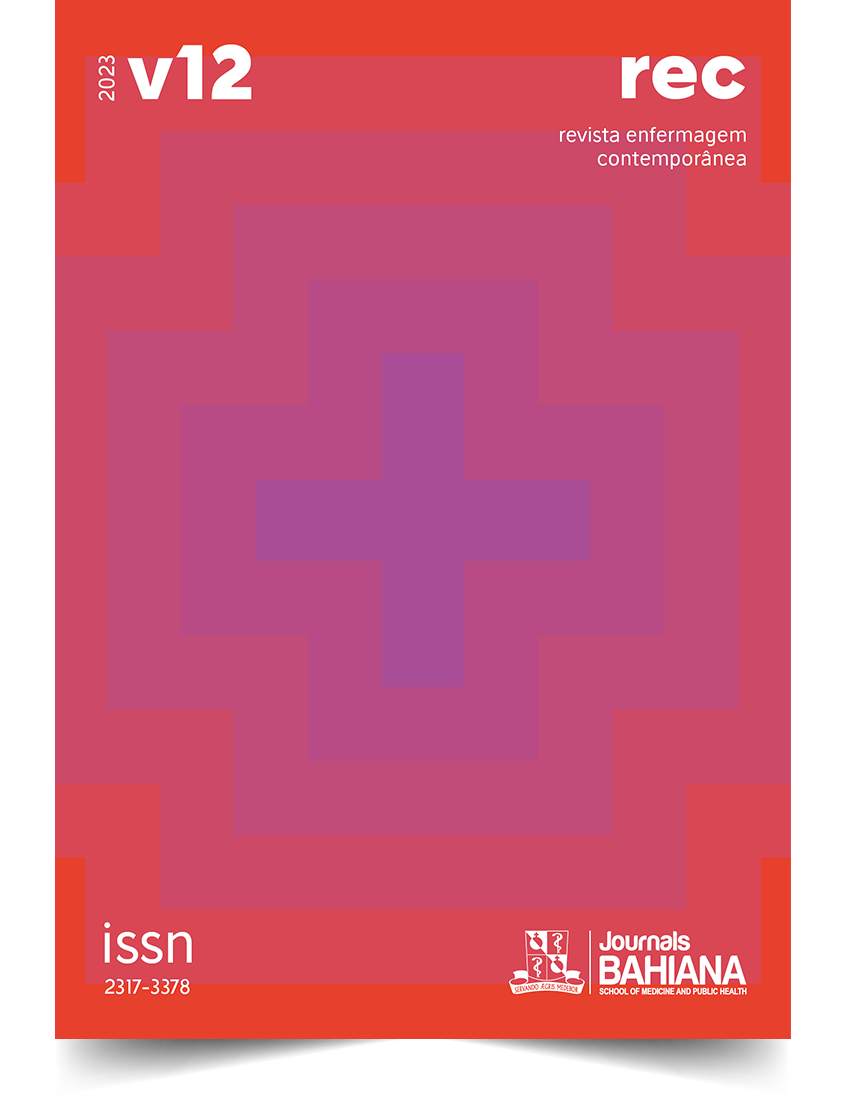Análise da prescrição medicamentosa dos idosos atendidos em um ambulatório de geriatria
DOI:
https://doi.org/10.17267/2317-3378rec.2023e5162Palavras-chave:
Envelhecimento, Polifarmácia, Medicamentos Potencialmente Inapropriados, BeersResumo
OBJETIVO: Avaliar a prescrição medicamentosa dos idosos atendidos em um ambulatório geriátrico baseado Consenso Brasileiro de Medicamentos Potencialmente Inapropriados para Idosos (MPI). METODOLOGIA: Trata-se de uma pesquisa descritiva com análise retrospectiva do prontuário eletrônico de pacientes com idade igual ou superior a 60 anos, atendidos no ambulatório geriátrico de um hospital baiano no período de janeiro a junho de 2018. Foram incluídos 291 prontuários e coletados os medicamentos que o idoso já fazia uso em seu domicílio e a prescrição vigente após a consulta. RESULTADOS: A idade mediana foi de 73 anos. Foi identificado que antes da consulta 89 idosos (30,6%) faziam uso de MPI e que após a consulta com geriatra 110 idosos (37,6%) passaram a utilizá-los, sem diferença estatística. A mediana de números de medicamentos posteriores à consulta ambulatorial foi maior do que anterior à consulta, com significância estatística (p<0,001). Constatou-se que dos idosos que não recorriam à polifarmácia, 20,4% começaram a utilizá-la após a consulta. CONCLUSÃO: Mesmo após a consulta com o geriatra ainda existem inadequações nas prescrições, com um número relevante de idosos utilizando cinco ou mais medicamentos e em uso de MPI.
Downloads
Referências
(1) Instituto Brasileiro de Geografia e Estatística. Evolução dos grupos etários 2010-2060 [Internet]. Rio de Janeiro: IBGE. Available from: https://www.ibge.gov.br/estatisticas/sociais/populacao/9109-projecao-da-populacao.html
(2) Albarqouni L, Palagama S, Chai J, Sivananthajothy P, Pathirana T, Bakhit M, Overuse of medications in low- and middle-income countries: a scoping review. Bull World Health Organ. 2023;101(1):36-61D. https://doi.org/10.2471/blt.22.288293
(3) Godoi DRS, Nascimento KBR, Nunes KJF, Silva TTA, Silva TKA. Polypharmacy and occurrence of drug interactions in elderly. Braz J Dev. 2021;7(3):30946-59. https://doi.org/10.34117/bjdv7n3-697
(4) Praxedes MFS, Pereira GCS, Lima CFM, Santos DB, Berhends JS. Prescribing potentially inappropriate medications for the elderly according to Beers Criteria: systematic review. Ciênc. Saúde Coletiva. 2021;26(8):3209-19. https://doi.org/10.1590/1413-81232021268.05672020
(5) Reis AMM, Alves CPB, Figueredo TP, Barroso SCC, Nascimento MMG. Adverse drug reaction as a contributing factor for hospitalization of the elderly. Rev. Bras. Farm. Hosp. Serv. Saúde. 2017;8(3):8-13. https://doi.org/10.30968/rbfhss.2017.083.002
(6) Rosa ASKC, Costa BP, Kapper CP, Dalmas GGS, Sbroglio LL, Andreis L, et al. Identification of inappropiate prescribing in a Geriatric outpatient clinic using the Criteria Stopp Start. Rev. Bras. Geriatr. Gerontol. 2016;19(5):871-9. https://doi.org/10.1590/1809-98232016019.150220
(7) Oliveira MG, Amorim WW, Borja-Oliveira CR, Coqueiro HL, Gusmão LC, Passos LC. Consenso brasileiro de medicamentos potencialmente inapropriados para idosos. Geriatr. Gerontol. Aging. 2016;10(4):1-14. https://doi.org/10.5327/Z2447-211520161600054
(8) Farias AD, Lima KC, Oliveira YMC, Leal AAF, Martins RR, Freitas CHSM. Prescription of potentially inappropriate medications for the elderly: a study in Primary Health Care. Ciênc. saúde coletiva. 2021;26(5):1781-92. https://doi.org/10.1590/1413-81232021265.04532021
(9) By the 2019 American Geriatrics Society Beers Criteria® Update Expert Panel. American Geriatrics Society 2019 Updated AGS Beers Criteria® for Potentially Inappropriate Medication Use in Older Adults. J Am Geriatr Soc. 2019;67(4):674-694. https://doi.org/10.1111/jgs.15767
(10) Moreira FSM, Jerez-Roig J, Ferreira LMBM, Dantas APQM, Lima KC, Ferreira MAF. Use of potentially inappropriate medications in institutionalized elderly: prevalence and associated factors. Ciênc. Saúde Coletiva, 2020;25(6):273-82. https://doi.org/10.1590/1413-81232020256.26752018
(11) Resende ACGD, Costa FBC, Gomes IR, Araújo JG, Suguino MM, Vidal CEL. Evaluation of drug use in the elderly according to Beers criteria. Rev. Med. Minas Gerais [Internet]. 2017;27(Suppl 1):S30-S36. Available from: https://rmmg.org/exportar-pdf/2037/v27s1a06.pdf
(12) Bueno D, Almeida TT, Rocha BS. Prevalence of potentially inappropriate drug prescription for elderly of Family Health Unit in Porto Alegre/RS. Rev. APS [Internet]. 2016;19(3):370-75. Available from: https://periodicos.ufjf.br/index.php/aps/article/view/15579
(13) Oliveira HSB, Corradi MLG. Pharmacological aspects of elderly: an integrative literature review. Rev. Med. (São Paulo). 2018;97(2):165-76. https://doi.org/10.11606/issn.1679-9836.v97i2p165-176
(14) Zhang Y, Chen Z, Tian F. Potentially inappropriate medications in older Chinese outpatients based on the Beers criteria and Chinese criteria. Front Pharmacol. 2022;13:991087. https://doi.org/10.3389/fphar.2022.991087
(15) Wang F, Ma Z, Liu M, Wu X. Potentially inappropriate medications at admission and discharge in older adults: A comparison of the Beers 2019 and 2015 criteria. Int J Clin Pharmacol Ther. 2020;58(6):299-309. https://doi.org/10.5414/cp203638
(16) Bai Y, Wang J, Li G, Zhou Z, Zhang C. Evaluation of potentially inappropriate medications in older patients admitted to the cardiac intensive care unit according to the 2019 Beers criteria, STOPP criteria version 2 and Chinese criteria. J Clin Pharm Ther. 2022;47(12):1994-2007. https://doi.org/10.1111/jcpt.13736
(17) Oliveira RMAF, Gorzoni ML, Rosa RF. Potentially inappropriate medication use in hospitalized elderly patients. Rev. Assoc. Med. Bras. 2022;68(6):797-801. https://doi.org/10.1590/1806-9282.20220015
(18) Gomm W, Von Holt K, Thomé F, Broich K, Maier W, Fink A, et al. Association of Proton Pump Inhibitors With Risk of Dementia: A Pharmacoepidemiological Claims Data Analysis. JAMA Neurol. 2016;73(4):410-16. https://doi.org/10.1001/jamaneurol.2015.4791
(19) Coluzzi F, Taylor Jr R, Pergolizzi Jr JV, Mattia C, Raffa RB. Good clinical practice guide for opioids in pain management: the three Ts - titration (trial), tweaking (tailoring), transition (tapering). Rev. Bras. Anestesiol. 2016;66(3):310-317. https://doi.org/10.1016/j.bjane.2014.09.005
(20) Primejdie DP, Bojita MT, Popa A. Potentially inappropriate medications in elderly ambulatory and institutionalized patients: an observational study. BMC Pharmacol Toxicol. 2016;17(1):38. https://doi.org/10.1186/s40360-016-0081-x
(21) Al Odhayani A, Tourkmani A, Alshehri M, Alqahtani H, Mishriky A. Potentially inappropriate medications prescribed for elderly patients through family physicians. Saudi J Biol Sci. 2017;24(1):200-07. https://doi.org/10.1016/j.sjbs.2016.05.006
(22) Wallace E, McDowell R, Bennett K, Fahey T, Smith SM. Impact of Potentially Inappropriate Prescribing on Adverse Drug Events, Health Related Quality of Life and Emergency Hospital Attendance in Older People Attending General Practice: A Prospective Cohort Study. J Gerontol A Biol Sci Med Sci. 2017;72(2):271-77. https://doi.org/10.1093/gerona/glw140
(23) Ministério da Saúde (Brasil), Secretaria de Atenção à Saúde, Departamento de Ações Programáticas e Estratégicas. Orientações técnicas para a implementação de Linha de Cuidado para Atenção Integral à Saúde da Pessoa Idosa no Sistema Único de Saúde – SUS [Internet]. Brasília: Ministério da Saúde; 2018. 93 p. Available from: https://bvsms.saude.gov.br/bvs/publicacoes/linha_cuidado_atencao_pessoa_idosa.pdf
Downloads
Publicado
Edição
Seção
Licença
Copyright (c) 2023 Letícia Kelly de Macedo Vaz, André Santos Pereira Ramos, Julia Lenza Goulart, Tercio Carneiro Ramos, Maria Emilia Santos Pereira Ramos

Este trabalho está licenciado sob uma licença Creative Commons Attribution 4.0 International License.
Esta obra está licenciada com uma Licença Creative Commons Atribuição 4.0 Internacional.



